|
Limitar tu búsqueda
[+–] Creator
- Aguilera, Nelly (1)
- Gameren, Edwin van (1)
- Guerrero, Ramiro (1)
- Gutiérrez, Cristina (1)
- Hernández Ángeles, Domingo F. (1)
- Herring, Andrew (1)
- Hughes Tuohy, Carolyn (1)
- Manuel Gutiérrez, Diana (1)
- Martínez, Gabriel (2)
- Miranda, Martha (1)
- Muiser, Jorine (1)
- Orcí, Sandra (1)
- Ramírez Medina, Edgar (1)
- Scott, John (1)
- Sinha, Tapen (1)
- Vargas, Juan Rafael (1)
- Zaragoza Castillo, Ricardo (1)
[+–] Editorial
[+–] Fecha
[+–] Formato
[+–] Idioma
[+–] Tipo de documento
[+–] Tipo de recurso
[+–] Classification
- Revistas -- Well-being and Social Policy [X]
|

|
|
Introduction (on the subject that is addressed in the issue number)
In this issue of Well-being and Social Policy we have tried to include articles that support the debate around social insurance in health. This is an issue in which simple answers are hardly ever found, and a long term effort is required to understand the idiosyncrasy of each country and the best mix of regulation and financing options. Additionally, the studied cases point out to the need of a...
|
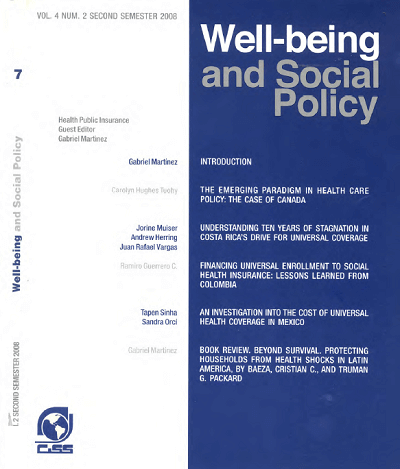
|
|
|
|

|
|
The emerging paradigm in heatlh care policy: the case of Canada
The model of health care financing and delivery for which Canada is best known internationally is its universal, single-payer, first-dollar system of coverage for physician and hospital services. For several decades following its establishment in the late 1950's and 1960's, this model provided public finance from the general tax base (like the UK), at levels of generosity, relative to GDP, like...
|

|
|
|
|

|
|
Understanding ten years of stagnation in Costa Rica's drive for universal coverage
This study analyzes achievements and obstacles in the process of moving towards universal coverage of essential health care services in Costa Rica. It describes the country as exemplary in the region, both in terms of population health status as well as health financing indicators. Life expectancy and the level of pre-payment are both comparable to high income countries. However, the process that...
|
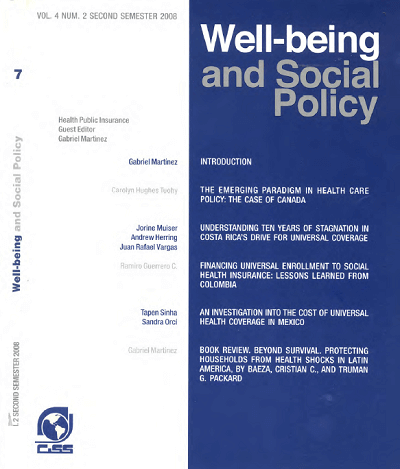
|
|
|
|

|
|
Financing universal enrollment to social health insurance: lessons learned from Colombia
The paper discusses the financing of the health care reform implemented in Colombia since the early nineties and explains the obstacles faced on the way to universal enrollment to social health insurance. The paper describes the reform and the sources created for its financing. It presents the observed trends in the financing of the insurance schemes created by the reform, identifies the...
|
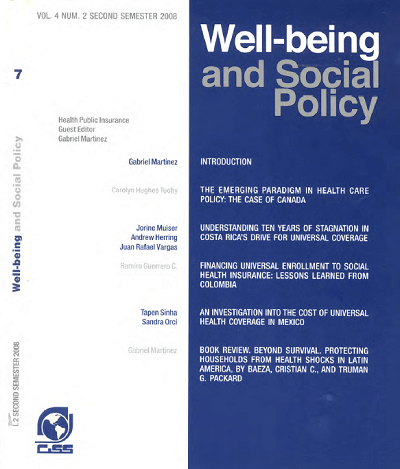
|
|
|
|

|
|
An investigation into the cost of universal health coverage in Mexico
The Mexican social security system, after operating for over six decades, has managed to provide healthcare for slightly over half the resident population.
There are wide geographical and socioeconomic variations in coverage. To provide wider coverage, the Federal Government created the Sistema de Protección Social en Salud (SPSS) for covering low income family. It becomes the third...
|

|
|
|
|

|
|
Book review. Beyond survival. Protecting households from health shocks in Latina America, by Baeza, Cristian C., y Truman G. Packard
The book by Cristian Baeza and Truman Packard is based on the next hypothesis: adverse health events reduce the consumption of goods and services different from health services, and many households become poor because of that. While the authors recognize that the evidence they present on the topic is limited, they propose the use of a “universal risk pool” as a way to eliminate the problem of...
|
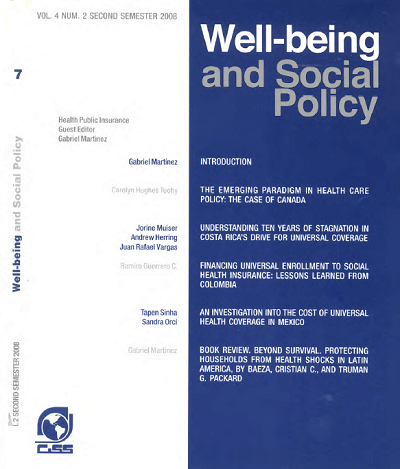
|
|
|
|

|
|
The health insurance reform in the Netherlands and its relevance for Mexico
Alrededor del mundo se observan dos versiones de la organización de los seguros de salud; la seguridad social basada en el empleo, y los servicios nacionales de salud. En Latinoamérica regularmente se usa la primera, pero se está lejos de lograr la cobertura universal. En los Países Bajos encontramos una peculiar mezcla de obligaciones públicas y responsabilidades privadas. La cobertura universal...
|

|
|
|
|

|
|
Feasibility analysis of an integrated health system: financial and distributive implications
The document presents spending projections and projections of the distributive incidence for an Integrated Health System under three basic scenarios: status quo, a two pillar scheme (financed through general taxes and private spending) and a three pillar scheme (financed through general taxes, social security contributions and private spending). By presenting these simulations, the study enhances...
|
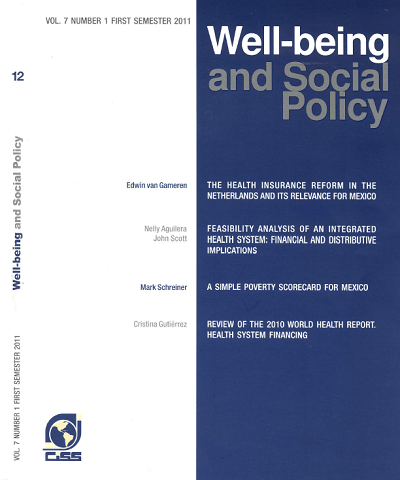
|
|
|
|

|
|
Review of the 2010 World Health Report. Health system financing
The document that was presented by the World Health Organization (WHO) in February 2011 sets forth a series of proposals to encourage member countries to achieve universal health coverage. These proposals are presented in detail and are based both on world statistics and case
studies.
|
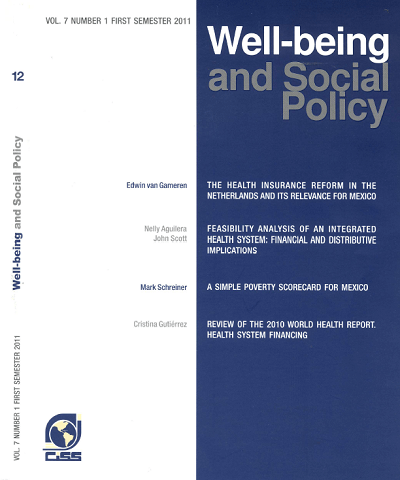
|
|
|
|

|
|
Book review. Empleo, trabajo y desigualdades en salud: una visión global. Joan Benach, Charles Muntaner, Orielle Solar, Vilma Santana y Michael Quinlan
This is a stimulating book which explores the relationship between employment conditions and health outcomes. The authors provide a conceptual framework to illustrate the channels through which health outcomes are determined and affected; this framework includes individual and aggregate variables, such as the economic, political and environmental conditions. The book also includes case studies...
|
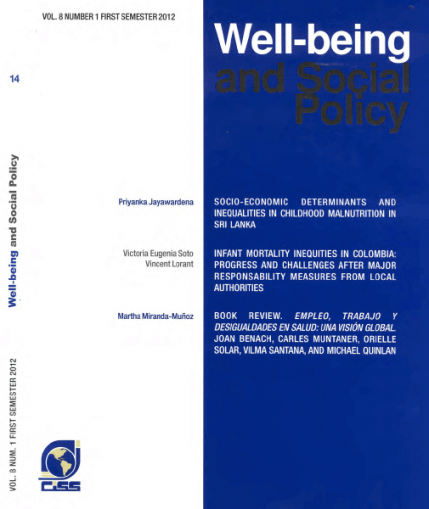
|
|
|
|

|
|
Relationship between social capital and health indicators in Mexico
This study analyzes the relationship between social capital types and access to health services in Mexico. To this end, access to healthcare data from the 2006 ENCASU and 2011 ENCAS was validated using 2006 and 2012 ENSANU results. Indicators were found to be consistent. A statistical analysis of the distribution of social capital and health indicators by region, as well as by rural or urban area...
|
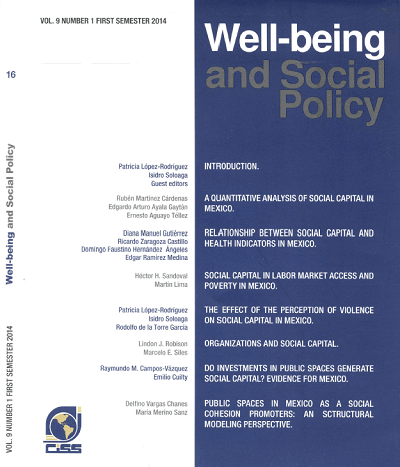
|
|
|
|
|